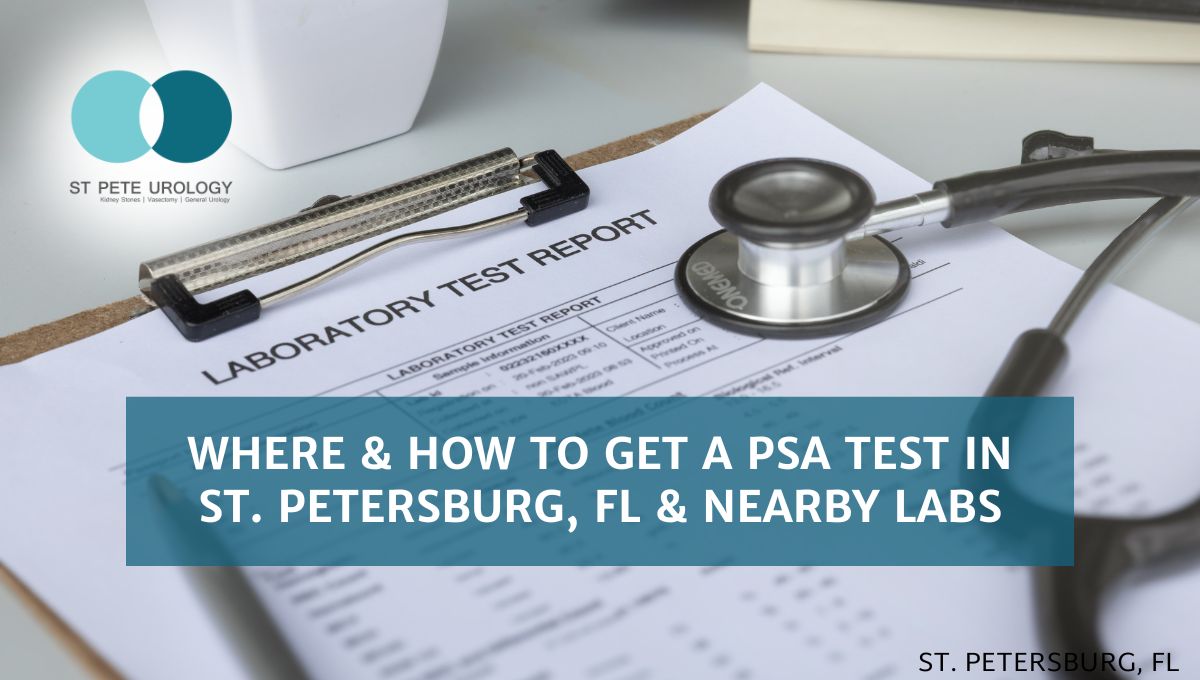Active surveillance offers low-risk prostate cancer patients a safe alternative to immediate treatment. Learn about monitoring protocols, eligibility criteria, and long-term outcomes from St Pete Urology’s experts.
Continue readingWhere & How to Get a PSA Test in St. Petersburg, FL & Nearby Labs
Getting a PSA test in St. Petersburg is straightforward—multiple labs across the city offer same-day walk-ins, and direct-to-consumer options eliminate the need for a doctor’s visit.
Continue readingTreatment Options for Prostate Cancer Explained
Explore prostate cancer treatment options, from active surveillance to surgery, with insights tailored for St. Petersburg patients. Understand your choices.
Continue readingEarly Signs of Prostate Cancer: What Should Men Know?
Discover the early signs of prostate cancer, from urinary changes to subtle red flags, and learn when men in St. Petersburg should schedule screenings.
Continue readingWhat is Robotic Prostatectomy?
Key Takeaways:
- The da Vinci Robotic Radical Prostatectomy is an innovative surgical technique used to remove the prostate in patients diagnosed with prostate cancer.
- The da Vinci robot provides for less blood loss, smaller incisions, a shorter hospital stay, and quicker recovery than the open approach.
- St Pete Urology in St. Petersburg, FL is leveraging advancements in technology for the benefit of their patients with a commitment to personalized care.
 You are living in a time of rapid medical advancement. Nowhere is this progress more evident than in the world of urology, specifically in the treatment of prostate cancer. The once fear-inducing prospect of a radical prostatectomy to combat this disease has been transformed. This transformation has come with the advent of robotic technology. The introduction of the da Vinci robotic radical prostatectomy has revolutionized the way prostate cancer is treated. It has weaved together the threads of technology, human ingenuity, and surgical precision.
You are living in a time of rapid medical advancement. Nowhere is this progress more evident than in the world of urology, specifically in the treatment of prostate cancer. The once fear-inducing prospect of a radical prostatectomy to combat this disease has been transformed. This transformation has come with the advent of robotic technology. The introduction of the da Vinci robotic radical prostatectomy has revolutionized the way prostate cancer is treated. It has weaved together the threads of technology, human ingenuity, and surgical precision.
“Hi, I’m Dr. Nicholas Laryngakis, board certified urologist with St Pete Urology. Some patients are diagnosed with prostate cancer and elect to have surgical removal of their prostate for their best chance of cure,” explains Dr. Laryngakis in an introduction that can put even the most anxious patient at ease.
The Dawn of a New Era in Prostatectomy
Let’s first understand what exactly, at its most fundamental level, robotic prostatectomy is. At the forefront of this innovative surgical technique is the da Vinci Robotic Radical Prostatectomy. This procedure is employed to remove the prostate in patients diagnosed with prostate cancer. Furthermore, the notion of a robot performing surgery may sound like something out of a science fiction novel. However, it is a reality in today’s medical world.
According to Dr. Laryngakis, “The da Vinci robot is the newest technology used to remove the prostate. It provides for less blood loss, smaller incisions, a shorter hospital stay, and quicker recovery. Additionally, this allows patients to return home and resume normal activities sooner than the traditional open approach.” With these benefits, it’s easy to see why this technology has become the preferred method for many urologists in St. Petersburg, FL, and beyond.
Tailoring the Treatment to the Patient
Admittedly, while the da Vinci Robotic Radical Prostatectomy has its advantages, it is not the only solution for prostate cancer treatment. There are traditional open approaches. And, a patient’s individual circumstances will ultimately dictate which method is chosen.
“Both approaches can be done depending on the patient’s situation, but most robotic prostatectomies are the way to treat prostate cancer,” Dr. Laryngakis clarifies. The ability to provide both types of treatment highlights the versatility of modern urology and reinforces the importance of personalized healthcare.
A Beacon of Hope in St. Petersburg, FL
Nestled in St. Petersburg, FL, at the heart of the dynamic Tampa Bay area, you’ll find a urology practice that’s making waves in the fight against prostate cancer. At St. Pete Urology, a team of dedicated professionals, led by board-certified urologists like Dr. Laryngakis. They stand at the forefront of advancing prostate cancer treatment through da Vinci Robotic Radical Prostatectomy.
St. Pete Urology doesn’t just focus on providing top-notch healthcare. Also, they understand that the battle against prostate cancer is both a physical and emotional fight. With a commitment to patient-centric care and a skilled, compassionate team, they offer access to state-of-the-art technologies, including the da Vinci robot. As a result, this makes their practice a beacon of hope for many individuals battling prostate cancer.
In an era where advancements in technology are impacting all areas of life, healthcare stands out as one of the most profoundly touched sectors. As you navigate this landscape, having trustworthy medical professionals on your side is essential. Dr. Laryngakis and his team are demonstrating that when it comes to the fight against prostate cancer. Furthermore, a robotic prostatectomy is a powerful tool in the hands of a skilled urologist. The future of prostate cancer treatment shines brightly in places like St. Petersburg, FL. Here, medical practices like St Pete Urology are leveraging these advancements for the benefit of their patients.
References:
- St Pete Urology. (2011, November 2). Prostate Cancer. St Pete Urology. https://stpeteurology.com/prostate-cancer/
- St. Pete Urology | Urologists in St Petersburg, Florida. (2020, September 14). St Pete Urology. https://stpeteurology.com/da-vinci-laparoscopic-radical-prostatectomy/
- Radical prostatectomy: MedlinePlus Medical Encyclopedia. (2020). Medlineplus.gov. https://medlineplus.gov/ency/article/007300.htm
- Health. (2022). Prostatectomy – for cancer. Vic.gov.au. https://www.betterhealth.vic.gov.au/health/conditionsandtreatments/prostatectomy-for-cancer
- Robotic Surgery for Cancer: The Da Vinci Surgical System. (2022, April). City of Hope. https://www.cancercenter.com/treatment-options/surgery/surgical-oncology/robotic-surgery
Technologic Innovations in Urology at St Pete Urology
Key Takeaways:
- St. Pete Urology is at the forefront of integrating advanced technologies like the DAVINCI robot and URONAV MRI ultrasound fusion biopsy technique into their medical practice, offering improved detection and treatment of urological diseases.
- These technological innovations in urology allow for less blood loss and quicker patient recoveries.
- At St. Pete Urology, their commitment to delivering top-quality, technologically advanced care makes them a top choice for anyone seeking urology services in Florida.
If you are seeking innovative solutions for urological issues, look no further than St. Petersburg, FL. As stated by the board-certified urologist Dr. Nicholas Laryngakis, “Urology is a very innovative field.” Based in St. Petersburg, FL, Dr. Laryngakis and his team of skilled urologists at St. Pete Urology have been pioneering advancements in the realm of urology, with technology playing an instrumental role in enhancing patient care, diagnosis, and treatment plans.
Revolutionizing Urology with the DAVINCI Robot
 St Pete Urology is at the forefront of integrating advanced technological solutions like the DAVINCI robot into their medical practices. Dr. Laryngakis proudly affirmed, “We were one of the first urology groups to utilize the DAVINCI XI robot on the west coast of Florida.” This cutting-edge tool marks a significant stride in the evolution of urology treatments in St Petersburg, offering a whole new approach to treating prostate and kidney cancer, as well as other urologic diseases.
St Pete Urology is at the forefront of integrating advanced technological solutions like the DAVINCI robot into their medical practices. Dr. Laryngakis proudly affirmed, “We were one of the first urology groups to utilize the DAVINCI XI robot on the west coast of Florida.” This cutting-edge tool marks a significant stride in the evolution of urology treatments in St Petersburg, offering a whole new approach to treating prostate and kidney cancer, as well as other urologic diseases.
The use of the DAVINCI robot underscores the crystallization of innovation and medical excellence at St Pete Urology. It’s not just about the ‘cool factor’ of the technology; it’s about the tangible benefits this technology brings to patients. As Dr. Laryngakis explains, “This provides for less blood loss and quicker patient recoveries.”
Improved Cancer Detection with the URONAV MRI Ultrasound Fusion Biopsy Technique
Another indispensable tool in the technological arsenal of St. Pete Urology is the URONAV MRI ultrasound fusion biopsy technique, which is utilized for prostate cancer detection. Dr. Laryngakis elucidates that this technique steps in “if patients have an elevated PSA or abnormal rectal exam and require a prostate biopsy for diagnosis of cancer.”
The URONAV MRI ultrasound fusion biopsy technique is engineered for precision. It leverages MRI images that are fused with a URONAV-guided biopsy technique. This innovative combination bolsters detection rates, thus promising a more robust and accurate diagnosis for patients.
St Pete Urology: A Vanguard of Innovations in Urology
As you look ahead to your urological healthcare choices, especially if you are based in St. Petersburg, FL consider St Pete Urology. They are not just a team of proficient urologists but pioneers who continually embrace and implement advanced technological innovations in their practices.
In the words of Dr. Laryngakis, “Urology is a very innovative field,” and it is clear that St Pete Urology is actively shaping that field. They employ the DAVINCI robot for surgical procedures. Additionally, they utilize the URONAV MRI ultrasound fusion biopsy technique. These approaches are turning the tide in the detection and treatment of urological diseases.
While the world of urologic treatment can seem intimidating, rest assured that with St Pete Urology, you are not just a patient, but a partner in your healthcare journey. They serve as a beacon of innovation. Their commitment to delivering top-quality, technologically advanced care makes them a top choice for urology services in Florida. Choose St Pete Urology, where technology meets compassion, and innovations in urology pave the way to better health.
References:
- St. Pete Urology | Urologists in St Petersburg, Florida. (2022, July 11). St Pete Urology. https://stpeteurology.com/robotic-surgery/
- St Pete Urology. (2011, November 2). Prostate Cancer. St Pete Urology. https://stpeteurology.com/prostate-cancer/
- Gyles, C. (2019). Robots in medicine. The Canadian Veterinary Journal = La Revue Veterinaire Canadienne, 60(8), 819–820. https://www.ncbi.nlm.nih.gov/pmc/articles/PMC6625162/
- UroNav. (2023). Philips. https://www.philips.com.ph/healthcare/product/HC784026/uronav-mrultrasound-guided-fusion-biopsy-system
- Prostate biopsy. (2021). Prostate Cancer UK. https://prostatecanceruk.org/prostate-information-and-support/prostate-tests/prostate-biopsy
Prostate Enlargement: The Silent Issue Men Ignore
Key Takeaways:
- Prostate enlargement, or BPH, is a common part of the aging process for men, but it is often ignored.
- Symptoms of an enlarged prostate can range from increased urgency to urinate, difficulty starting a stream, to interrupted sleep, urinary tract infections, and even kidney damage.
- Healthy lifestyle choices, regular check-ups, and open conversations with healthcare providers are key to managing prostate enlargement effectively.

As a middle-aged man, you’re probably no stranger to the odd health problem here and there. Yet, one issue often sidestepped in conversation, and subsequently ignored, is prostate enlargement. This condition, clinically known as benign prostatic hyperplasia (BPH), is a typical part of the aging process for men. However, its importance cannot be understated; its silence is its most dangerous attribute.
Understanding Prostate Enlargement
Signs and Symptoms
The symptoms of an enlarged prostate can be gentle whispers at first; an increased urgency to urinate, difficulty starting a stream or feeling that the bladder isn’t entirely empty. As the condition progresses, these whispers can crescendo into a drumbeat, wreaking havoc on the wellbeing and daily life of those affected, causing interrupted sleep, urinary tract infections, and even kidney damage.
Diagnosis and Treatment Options
Diagnosis can be as simple as a digital rectal exam, where a Urologist can feel the size of the prostate, or a prostate-specific antigen (PSA) blood test. Treatment options are myriad and are chosen based on the severity and impact of the symptoms. Medications can be useful for reducing the size of the prostate and the accompanying symptoms. Minimally invasive procedures and surgeries are available for more severe cases.
Potential Complications
An enlarged prostate is not synonymous with prostate cancer, nor does it increase the odds of developing it. But the symptoms are certainly akin and should not be ignored. Sexual health, too, can be affected, with erectile dysfunction and reduced libido commonly reported in men with prostate enlargement.
Lifestyle Modifications for Prevention and Management
Adopting a healthy lifestyle can help both prevent and manage prostate enlargement. Regular exercise, a balanced diet, maintaining a healthy weight, and avoiding excessive alcohol and caffeine can go a long way toward reducing the risk and the severity of the condition. Managing symptoms can be as straightforward as scheduling regular bathroom visits and avoiding drinking fluids before bedtime.
Breaking the Silence: Encouraging Men to Seek Help
You don’t have to bear this burden in silence. There is a disquieting stigma surrounding prostate health, one that refrains men from discussing it openly. Regular check-ups and open conversations with healthcare providers go a long way in managing this condition effectively.
St Pete Urology, based in St. Petersburg, FL, offers comprehensive care for men suffering from prostate enlargement. With a team of board-certified urologists, cutting-edge diagnostic equipment, and a patient-centric approach, they are committed to breaking the silence surrounding this issue. Their dedicated physicians offer individualized treatment plans, from medical management to minimally invasive procedures and surgical interventions, ensuring optimum urinary health.
In conclusion, while prostate enlargement is a common part of aging, it should never be ignored. Remember, silence isn’t golden when it comes to your health. Untreated, unnoticed, it can have severe implications. So, take heed, and take action. St Pete Urology is ready to stand by you, help you reclaim your quality of life, and alleviate the silent issue of an enlarged prostate. You owe it to yourself. Your wellbeing deserves a voice.
References:
- St Pete Urology. (2013, March 11). What is Prostate Enlargement? St Pete Urology. https://stpeteurology.com/what-is-prostate-enlargement/
- and, D. (2023, July 31). Prostate Enlargement (Benign Prostatic Hyperplasia). National Institute of Diabetes and Digestive and Kidney Diseases; NIDDK – National Institute of Diabetes and Digestive and Kidney Diseases. https://www.niddk.nih.gov/health-information/urologic-diseases/prostate-problems/prostate-enlargement-benign-prostatic-hyperplasia
- NHS Choices. (2023). Overview – Benign prostate enlargement. https://www.nhs.uk/conditions/prostate-enlargement/
- Prostate-Specific Antigen (PSA) Test. (2022, March 11). National Cancer Institute; Cancer.gov. https://www.cancer.gov/types/prostate/psa-fact-sheet
Defeat Prostate Enlargement: Tips for a Healthier Life
Key Takeaways:
1. Diet and physical exercise can contribute to maintaining prostate health.
2. Stress management techniques such as meditation and yoga can help manage stress levels and positively impact prostate health.
3. Healthy habits such as maintaining a healthy weight, limiting alcohol consumption, and quitting smoking can boost prostate health, as well as consulting a healthcare professional before starting any supplement regimen.
 Prostate enlargement, medically known as benign prostatic hyperplasia (BPH), is a condition that stealthily chips away at men’s health and quality of life. Affecting primarily older men, it poses an ongoing challenge to their well-being. The silver lining, however, is that adopting a healthier lifestyle can effectively combat this medical condition.
Prostate enlargement, medically known as benign prostatic hyperplasia (BPH), is a condition that stealthily chips away at men’s health and quality of life. Affecting primarily older men, it poses an ongoing challenge to their well-being. The silver lining, however, is that adopting a healthier lifestyle can effectively combat this medical condition.
Understanding Prostate Enlargement: Causes and Symptoms
To understand prostate enlargement and its implications, let’s delve into its primary cause: BPH. This noncancerous increase in the size of the prostate gland can lead to irritating urinary symptoms and, in severe cases, bladder, urinary tract or kidney problems. Symptoms can include frequent urination, difficulty starting urination, weak urine flow, and the feeling of incomplete bladder emptying. Recognizing these signs early can assist in diagnosing and treating the condition swiftly.
The Role of Diet in Prostate Health
Diet plays an instrumental role in maintaining prostate health. Incorporating a balanced diet rich in fruits, vegetables, lean proteins, and whole grains can contribute to a healthy prostate. Nutrients like zinc, selenium, and lycopene found in foods like shellfish, Brazil nuts, and tomatoes respectively, support prostate health. Conversely, red meat, dairy products, and alcohol, linked with increased prostate enlargement risk, should be limited.
Regular Exercise and Prostate Enlargement
Physical exercise is another stronghold in your arsenal against prostate enlargement. Regular exercise, particularly aerobic and resistance training, can help maintain a healthy weight and reduce the risk of BPH. Whether it’s swimming, cycling, or a brisk walk around the block, the key is consistency. Aim for at least 30 minutes of moderate exercise most days of the week.
Stress Management and Prostate Health
Stress, the silent enemy, often exacerbates prostate health problems. Chronic stress can lead to hormonal changes potentially contributing to prostate enlargement. Mindfulness meditation, deep-breathing exercises, and yoga can help manage stress levels effectively, positively impacting prostate health.
Healthy Habits for Optimal Prostate Health
A handful of good habits can further augment your prostate health. Maintaining a healthy weight, limiting alcohol consumption, and quitting smoking can remarkably boost your prostate health. Coupled with regular check-ups and screenings, these habits facilitate early detection and treatment.
Natural Remedies and Supplements for Prostate Health
There are also natural remedies and supplements that hold promise for prostate health. Saw palmetto, beta-sitosterol, and Pygeum are regarded as beneficial for managing prostate enlargement symptoms. However, they are not devoid of side effects and interactions. Hence, consulting with a healthcare professional before starting any supplement regimen is advisable.
Stepping back, one realizes that leading a healthier life isn’t merely a slew of practices but a holistic change in perception and lifestyle. The road to combat prostate enlargement is paved with balanced diets, regular exercise, stress management, healthy habits, and regular medical check-ups.
But, remember, this journey need not be traversed alone. Personalized advice from healthcare professionals like those at St Pete Urology, a leading urology practice in St Petersburg, Florida, can make all the difference. St Pete Urology is dedicated to providing expert, compassionate care to guide you in your battle against prostate enlargement. With their focus on individualized treatments, state-of-the-art facilities, and experienced professionals, achieving a healthier, happier life is more than just a distant possibility. Make your health a priority today, because nothing you do tomorrow can bring back the day you lose today.
References:
- St Pete Urology. (2018, June 13). Prostate Enlargement BPH. St Pete Urology. https://stpeteurology.com/prostate-enlargement-bph/
- Benign prostatic hyperplasia (BPH) – Symptoms and causes. (2023). Mayo Clinic; https://www.mayoclinic.org/diseases-conditions/benign-prostatic-hyperplasia/symptoms-causes/syc-20370087
- Benign Prostatic Hyperplasia and Complementary and Integrative Approaches. (2022). NCCIH; NCCIH. https://www.nccih.nih.gov/health/providers/digest/benign-prostatic-hyperplasia-and-complementary-and-integrative-approaches
- Natural ways to treat an enlarged prostate – Harvard Health. (2023, February 14). Harvard Health; Harvard Health. https://www.health.harvard.edu/mens-health/natural-ways-to-treat-an-enlarged-prostate
What Are the Different Types of Prostate Problems? – Dr. Adam Oppenheim
Key Takeaways:
- There are two main types of prostate problems: Benign Prostatic Growth and Prostate Cancer.
- Early detection is key in managing and treating prostate cancer and should begin at age 50 (or 45 for those with a family history or higher risk factors).
- Treatment for both benign prostatic growth and prostate cancer depends on various factors and should be personalized to meet each patient’s unique needs.
Getting to Know Your Prostate
As the wise Dr. Adam Oppenheim says, “I’m a urologist with St. Pete Urology.” And who better to enlighten us on the different types of prostate problems than a seasoned professional? So, sit back and let’s delve into the world of prostate health.
First, let’s begin with some basics. The prostate is a walnut-sized gland located just below the bladder in men. Its primary function is to produce the fluid that nourishes and transports sperm. While this may seem like a small and insignificant part of the male anatomy, it can cause significant problems if not properly cared for.
Two Main Types of Prostate Problems
Dr. Oppenheim outlines two main issues in urology related to the prostate:
- Benign Prostatic Growth
- Prostate Cancer
Let’s take a closer look at each of these issues.
Benign Prostatic Growth: When Nature Takes Its Course
As Dr. Oppenheim explains, benign prostatic growth occurs when “patients have trouble urinating and they’re very bothered and often have to urinate very frequently or have a blocked stream.” This condition is known as Benign Prostatic Hyperplasia (BPH) and is a natural part of the aging process for men.
However, the symptoms of BPH can be quite bothersome, including:
- Frequent urination
- Difficulty starting and stopping urination
- Weak urine stream
- Dribbling of urine
While BPH is not life-threatening, it can significantly impact a man’s quality of life. Treatment options vary depending on the severity of symptoms and may include medications, minimally invasive procedures, or surgery.
Prostate Cancer: The Silent Threat
The second issue, prostate cancer, is a more sinister problem. Dr. Oppenheim informs us that “it doesn’t usually cause symptoms, but it can cause life-threatening cancer down the road if not treated.” This type of cancer occurs when malignant cells begin to grow uncontrollably in the prostate gland, often without any noticeable symptoms.
Early detection is key in managing and treating prostate cancer. Dr. Oppenheim suggests that men should begin screening for prostate cancer at age 50 (or 45 for those with a family history or higher risk factors). Regular screening tests, such as a prostate-specific antigen (PSA) blood test and digital rectal exam (DRE), can help identify any abnormalities in the prostate gland.
Choosing the Right Path: Customized Treatment Options for Prostate Problems
The course of treatment for both benign prostatic growth and prostate cancer depends on various factors, including the severity of the condition, age, overall health, and personal preferences. Dr. Oppenheim and the experts at St. Pete Urology offer personalized treatment plans designed to meet each patient’s unique needs.
For BPH, treatment options may include medication management, minimally invasive procedures, or surgery. For prostate cancer, treatment options can range from active surveillance (monitoring) to radiation or surgery, depending on the stage and aggressiveness of the cancer.
Conclusion: Trusting Your Prostate Health to St Pete Urology
Dr. Adam Oppenheim and the team at St Pete Urology in St Petersburg, Florida, understand the importance of early detection and customized treatment plans for men dealing with prostate problems. As Dr. Oppenheim says, “prostate health is a vital component of overall well-being, and we are here to help you navigate the complexities of this often-misunderstood aspect of men’s health.”
Don’t leave your prostate health to chance. Trust the urology professionals at St Pete Urology to provide the expertise and compassionate care you need. Schedule an appointment today and take control of your prostate health.
References:
- “Prostate disease – Better Health Channel.” https://www.betterhealth.vic.gov.au/health/conditionsandtreatments/prostate-disease.
- “Benign Prostatic Hyperplasia (BPH) – Urology Care Foundation.” https://www.urologyhealth.org/urology-a-z/b/benign-prostatic-hyperplasia-(bph).
- “Prostate Cancer: Types of Treatment.” https://www.cancer.net/cancer-types/prostate-cancer/types-treatment.
Transcription:
I’m Dr. Adam Oppenheim, I’m a urologist with St. Pete Urology.
So the prostate, there’s kind of two main issues in urology with the prostate.
There’s benign prostatic growth where patients have trouble urinating and they’re very bothered and often have to urinate very frequently or have a blocked stream.
And then there’s prostate cancer which is different and that doesn’t usually cause symptoms but it can cause life threatening cancer down the road if not treated.
The Role of Stress in Prostate Enlargement: What You Need to Know
Key Takeaways:
- Stress can lead to an enlarged prostate due to increased levels of hormones and a decrease in zinc levels.
- The release of adrenaline due to stress can cause the bladder and prostate to shut down, resulting in more difficult and painful urination.
- Managing stress through lifestyle and behavioral changes such as exercise, sleep and therapy can help prevent prostate enlargement and ease its symptoms.
 The prostate is a small, walnut-sized gland that forms part of the male reproductive system. It sits right below the bladder and surrounds the top portion of the urethra.
The prostate is a small, walnut-sized gland that forms part of the male reproductive system. It sits right below the bladder and surrounds the top portion of the urethra.
Its primary function is to secrete an alkaline fluid that adds to the bulk of semen—a mixture of seminal, bulbo-urethral, and prostatic fluid.
With its sphincter muscles, the prostate seals off the entry from the bladder into the urethra, preventing the flow of urine during sexual intercourse. Plus, it contains muscles that help to expel semen out of the penis during sexual intercourse.
Hormone-dependent enlargement
The prostate doesn’t remain tiny for life. It undergoes two phases of hormone-dependent growth: the first at puberty when it nearly doubles its size, and the second after 25 years and for the rest of life.
Now, the prostate requires testosterone to function. But it also contains the enzyme 5-alpha reductase, which converts testosterone to dihydrotestosterone (DHT).
DHT is responsible for development of various male characteristics, such as facial hair. And it equally promotes the enlargement of the prostate.
In fact, if you live long enough, the increased levels of DHT will ensure a continued growth of the gland until you have a condition called an enlarged prostate.
Also called BPH (benign prostatic hyperplasia), an enlarged prostate is a condition where the gland has grown large enough to press or pinch the urethra and cause urinary symptoms.
It occurs in roughly 30% of men over 50 years and in 90% of men aged 80 years.
What is the role of stress in an enlarged prostate?
Stress and BPH are highly related. In fact, the more stressed you become, the worse your BPH symptoms get. And the worse your BPH symptoms get, the more stressed you feel. It is an endless cycle.
But how is stress related to prostate enlargement?
And what should you know about that relationship?
- Stress affects hormones that trigger prostate enlargement
When your body is stressed, it releases more of the cortisol hormone. In men, cortisol suppresses other key hormones such as testosterone.
Now, as your level of testosterone drops, the level of estrogen increases. And the increased level of estrogen indirectly promotes the growth of prostate cells, resulting in an enlarged prostate.
Also, stress increases the rate of conversion of testosterone to dihydrotestosterone (DHT). When an increased level of DHT accumulates in the prostate, it triggers rapid cell growth and development.
While low levels of DHT may not cause an enlarged prostate, a very high level resulting from extreme, prolonged stress eventually causes prostate enlargement.
Actually, DHT is the central hormone responsible for the growth of the prostate both in puberty and young adulthood. Hence, increased levels of DHT due to stress are an important factor in prostatic enlargement.
- Stress depletes zinc
Stress usually causes body zinc levels to reduce significantly.
Zinc is a critical mineral for the prostate, controlling the gland’s rate of expansion. It occurs more commonly in the prostate than in any other human tissues.
So when zinc deficiency occurs due to prolonged stress, the prostate gland enlarges rapidly, resulting in an enlarged prostate.
If you already have BPH, then reduced zinc levels tend to worsen its symptoms.
By reducing stress and eating zinc-rich foods, such as pumpkin seeds, you can boost your body zinc levels, prevent rapid growth of the prostate, and ease BPH symptoms.
- Stress promotes adrenaline secretion
When your body is in a stressful situation, it gets into a ‘flight or fight’ mode that triggers the release of increased quantities of adrenaline.
The adrenaline triggers contraction of muscles of the prostate and bladder. As a result, the prostate compels the urethra to narrow, making passing urine more difficult and painful.
Also, the released adrenaline may cause the bladder to effectively ‘shut down’, worsening urinary symptoms.
So stress is bad for you if you already have an enlarged prostate. It elevates the amount of adrenaline in your body, which impacts both the bladder and prostate and worsens BPH symptoms.
- Stress increases tension in pelvic floor muscles
Lastly, when stressed, your pelvic floor muscles become tenser. And the tightening of these muscles forces the urethra to narrow.
In turn, this makes urine flow more difficult. Hence, if you already have an enlarged prostate, your symptoms become worse.
Prompt management of stress for BPH
If you have an enlarged prostate, it is important that you avoid or minimize stress. Speak about things that are stressing you or causing anxiety and depression with friends, family, or a therapist.
Also, consider lifestyle and behavioral changes to manage stress, including regular aerobic exercise, adequate sleep, and practicing yoga and meditation.
At St Pete Urology, we encourage healthy habits such as avoiding caffeine and minimizing fluid intake a few hours before bedtime. We also recommend speaking with a licensed therapist and joining a support group to help you with stress.
And for those with severe symptoms of an enlarged prostate, we recommend seeing a urologist for treatment to bring the symptoms under control. After that, you may only need annual checkups.
For more information on prevention, diagnosis, and treatment of benign prostatic enlargement and other urological problems, visit the site “St Pete Urology.”
References:
- “Benign Prostatic Hyperplasia (BPH).” Urology Health, Urology Health, www.urologyhealth.org/urology-a-z/b/benign-prostatic-hyperplasia-(bph).
- “Dihydrotestosterone.” Your Hormones, www.yourhormones.info/hormones/dihydrotestosterone/.
- “Enlarged Prostate.” Healthline, Healthline Media, www.healthline.com/health/enlarged-prostate.
- “Prostate Enlargement.” National Health Service, National Health Service, www.nhs.uk/conditions/prostate-enlargement/treatment/.










